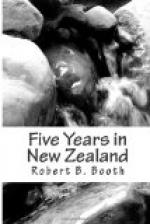When a tract of country is occupied for the first time, it will usually be found covered with tussocks of grass scattered far apart and lying matted and rank on the ground. The first thing to do is to apply the match and burn all clean to the roots, and after a few showers of rain the grass will begin to sprout from the burnt stumps. Then the sheep are turned on to it, and the cropping, tramping, and manuring it receives, with occasional further burnings, renders it in a couple of years fair grazing country. An even sod takes the place of the isolated tussock, and the grass from being wild and unsavoury becomes sweet and tender.
It takes, however, three to five years to transform a wild mountain side (if the land be moderately good) into an ordinarily fair sheep-run calculated to carry one sheep to every five acres—that is, of course, for the native or indigenous grass; the same ground cleared and laid down in English grass would carry three to five sheep to the acre.
A settler having obtained his run is bound by Government to stock it within a year with a stipulated number of sheep per 1,000 acres, failing which he forfeits his claim to possession. A man holding a fairly good run of 30,000 acres may feed from 3,000 to 4,000 sheep upon it, making due allowance for increase and disability to dispose of surplus stock.
The farming is conducted as follows: The flock is divided into two or more parts, in all cases the wethers being kept separate from the ewes and lambs, and occupying different portions of the run, the object being that the ewes and lambs may have rest, the wethers being liable to be driven in for sale or slaughter.
A shepherd is put in charge of each flock, and he resides at some convenient place on the boundary, whence it is his duty to walk or ride round his boundary at least once a day, and see that no sheep have crossed it. If he discovers tracks made during his absence he must follow them until he recovers his wanderers.
It is not necessary that a shepherd should see his sheep daily; he may not see a third of his flocks for months, unless he wishes to discover their actual whereabouts; he has only to assure himself that they have not left the run, and it is practically impossible for them to do so without leaving their footprints to be discovered on the boundary.
The breeding season is spring and the shearing season summer, which corresponds to our winter in England. The usual increase of lambs, if the ewes be healthy and strong, is 75 to 95 per cent. in about equal proportions of male and female.
When the lambs are about six weeks old the entire flock is driven in for cutting, tailing, and earmarking. The tails are cut off and the ear nicked or punched with the registered earmark of the station, and a certain number of the most approved male lambs are reserved. A good hand can cut and mark two thousand lambs per day, and not over one per cent. will die from the consequences. When the operation is over, the flock is counted out and handed over to the shepherd to take them back to their run until the shearing season.




